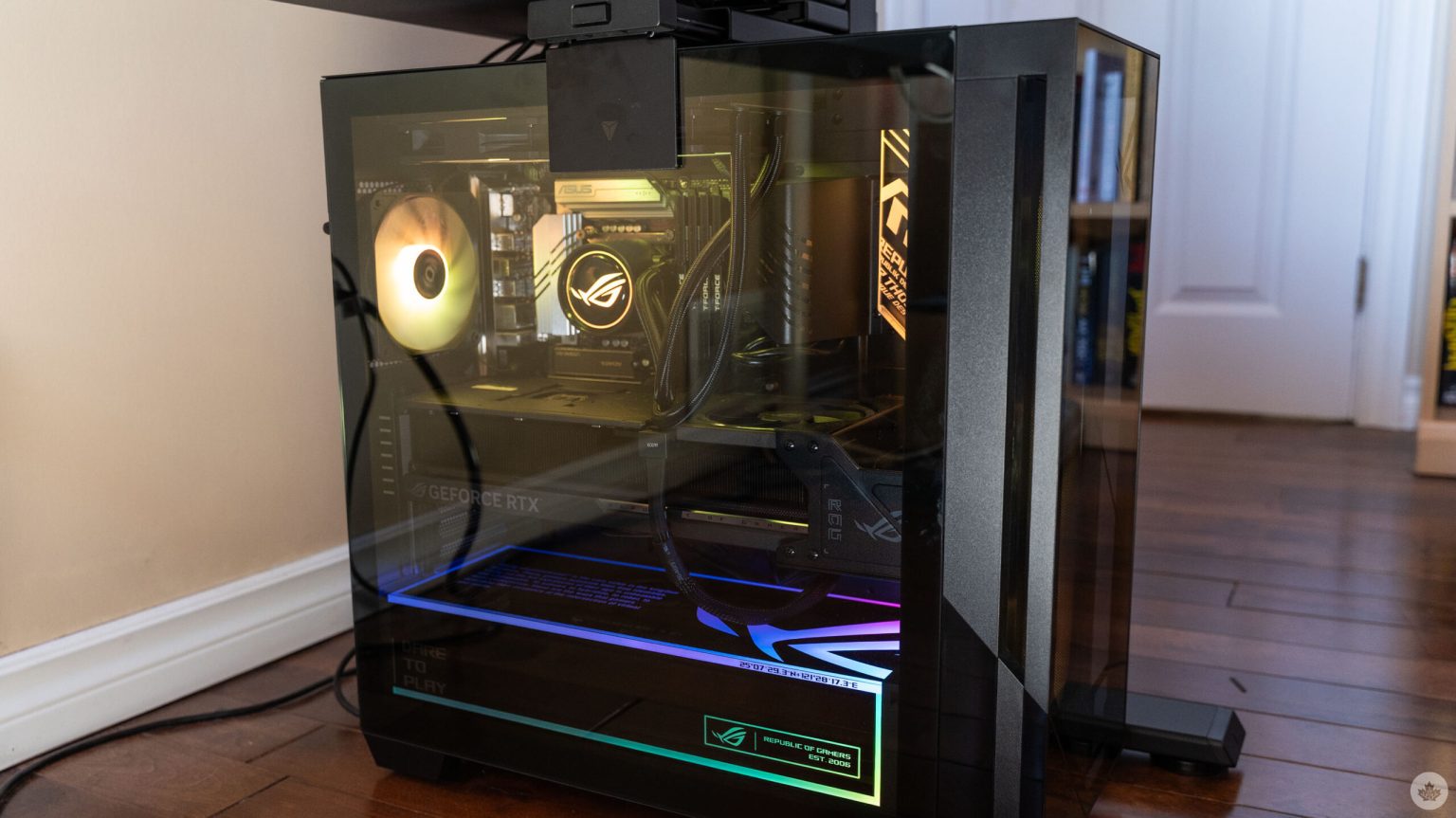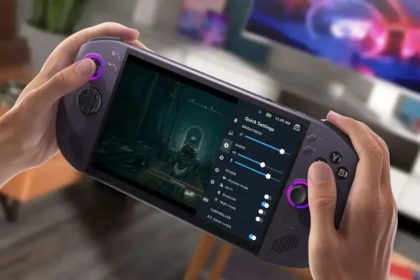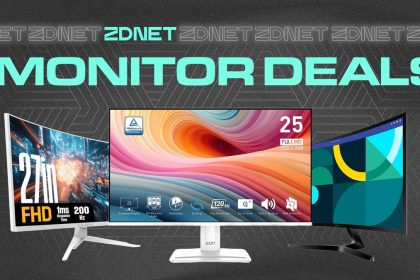I’ve been a PC gamer for years, and for most of that time, I was in the camp that building a custom PC was the way to go. However, in recent years, my position has shifted.
Part of that was my own personal circumstances — my life looks totally different now than it did when I built my first PC nearly a decade ago. For example, I’m a father now, and I don’t have the same amount of time I used to have to dedicate to projects like building a PC. Another major part is that I’ve tried out a prebuilt PC and come away extremely impressed.
I’ve been testing out one of Asus’ ROG G700 desktop PCs for a few months now, and it has wowed me. The G700 comes in several configurations with Intel Core Ultra or AMD Ryzen CPUs, Nvidia RTX 5070, 5080, or 5090 GPUs, and more (the spec list for my G700 is below).
Just from the parts alone, there’s a lot to be impressed by. But more than just parts, the G700 is well built and looks incredible. The quality is there, and it really looks like it was assembled by someone who cares.
Specs
Processor: Intel Core Ultra 7 265F
Graphics: Nvidia GeForce RTX 5090 ROG Astral with 32GB GDDR7
Memory: 64GB DDR5
Storage: 2TB SSD Adata Legend 860
Dimensions: 24.00 x 50.92 x 47.96 cm
Weight: 18kg (39.68lbs)
Operating System: Windows 11
Connectivity: Wi-Fi 6
Power Supply: 1000W
Ports: Front: 2x 3.5mm audio (1x headphone, 1x mic), 2x USB 3.2 Gen 1 Type A, 1x USB 3.2 Gen 1 Type-C. Rear: 1x RJ45 Ethernet, 1x Displayport 1.4, 3x audio, 4x USB 2.0 Type-A, 4x USB 3.2 Gen 1 Type-A, 1x USB 3.2 Gen 2 Type-A, 1x USB 3.2 Gen 2 Type-C.
The above specs are for the G700 unit I tested. Specs for all G700 configurations can be found on the Asus website.
GPU beast
When it comes to performance, the G700 is a beast. As I mentioned above, the configuration I have sports the Nvidia RTX 5090, which performed well in every game I tried. It’s certainly a huge step up from the AMD Radeon RX 5600XT in my custom-built PC, though at this point, basically any GPU would have been an upgrade.
The 5090 pumped out impressive framerates in most of the titles I benchmarked and in several other games I played. For example, I play a lot of Path of Exile 2 and, more recently, Warframe — neither has a bespoke benchmark to run, but my in-game experience was quite solid.
With PoE2, the 5090 allowed me to effectively double my framerate to a fairly solid 120fps, and it maintained that without any resolution downscaling. (PoE can automatically reduce the render resolution when there’s a lot happening on screen, and when playing on my 5600XT, it often reduced the resolution even when nothing was going on in the game.) I will note that PoE2 is in early access and has had a lot of performance issues as a result, but aside from early access-related problems, the game ran flawlessly on the G700.
Warframe isn’t the most graphically intense game — it runs on basically everything, including iPhones as far back as the 2018 models — but it ran incredibly well on the 5090 with all the settings pushed to the max.
Doom: The Dark Ages ran and looked incredible on the 5090. That isn’t a huge surprise — the last few Doom titles have run very, very well, so The Dark Ages continues that trend.
I also tried out the Battlefield 6 Open Beta with the 5090 and again, solid 120+fps almost the whole time, though I did see dips as low as 90fps in some intense scenarios. Overall, though, the game ran incredibly well, honestly the best performance I’ve seen in any Battlefield title I’ve played on PC.
There are a lot of other features on the 5090 that I have thoughts on — like ray-tracing, DLSS and multi-frame generation (MFG) — but I’ll save those for a separate post that digs deeper into the GPU and my experience making the leap to Nvidia after a long time using AMD hardware.
For now, I’ll cap off this section by noting that the 5090 ultimately is overkill for me and, frankly, probably most people. The 5090 shines best at 4K and with intense, VRAM-heavy professional applications, which aren’t things that I do.
I’ve long been a 1440p gamer, and frankly, I’d rather stick to that resolution and push higher framerates than step up to 4K. All this is to say, whether you’re looking at an Nvidia-equipped prebuilt or buying an Nvidia GPU for a custom PC, think about what your gaming goals are and pick a GPU to support that. There’s no point putting down the insane amount of money needed for a 5090 if you’re not going to play at 4K.
Maybe grab the AMD variant
While the GPU performance was great and bordering on overkill for me, the CPU performance left me feeling disappointed. In short, Intel’s current CPU lineup just isn’t great and is outshone by a lot of AMD chips, especially when it comes to efficiency and price.
Unfortunately, I don’t have any AMD CPUs to compare against in benchmarks for hard numbers, but anecdotally, I can say that the occasional hiccups I noticed while gaming were connected to the CPU. For example, in titles like PoE2, I noted that framerate drops often came alongside high CPU utilization, and it seemed to me like the Core Ultra 7 265 was struggling to keep up.
This plays out in other, in-depth CPU reviews I’ve seen, with the Ultra 7 265 frequently falling behind Intel’s Ultra 9 285K and even the 245K in some tests, and behind several lower-cost AMD options in most tests. And for those who want to do professional work on their PC, the 285 is a better option, though still not as good as AMD.
All this is to say, if you’re planning to pick up a G700 with the 5090, you might want to spend a little more for the 285 CPU instead of the 265. And if you’re okay with other GPU options, then I’d strongly recommend looking at some of the AMD-equipped G700s, though at the time of writing, Asus didn’t have any with 5080 or 5090 GPUs. As an aside, this is one of those instances where the pros of building your own rig emerge — instead of being tied to Asus’ configuration options, you can pick exactly what you want. But I’ll dive deeper into the pros and cons of buying a prebuilt in another article.
Inner Style
When it comes to looks, there’s only so much you can do with a PC case, but Asus still managed to make it look nice. The G700 resides in a fairly standard case with glass panels on the front and left side so you can see the components. The front glass sports an airflow gap, mesh dust filter and three intake fans, while the side glass panel allows for tool-less removal for easy access to the internals. While I haven’t tried a lot of PC cases, of the ones I have used, the G700 has the easiest side panel to take off and put on.
Naturally, nearly everything inside the case is covered in customizable RGB lighting. I found the RGB to be generally fine and not overbearing or garish. That said, when I power on the G700 for a late-night gaming sesh, it does light up my whole office. Thankfully, with some of the included software, you can tweak the lighting however you want, or even flat-out turn it off if you prefer. There are a ton of options for the lighting, and people can even create their own RGB patterns with Asus’ software. (I like a little RGB, so I set it to a colour theme I liked and then never touched it again.)
The G700 I tested sported an all-in-one (AIO) liquid cooler for the CPU, which minimized the internal clutter compared to having the giant fans of an air cooler. That doesn’t matter too much, but I do think it makes the internal components look a little nicer. Plus, it adds more RGB lighting as part of the CPU cooler, which is great if you’re into that.
Other notable design touches include a light-up glass ROG branding panel and RGB on the edges of the box at the bottom of the case, which houses the 1000W power supply and a good chunk of the cables.
Overall, I think the G700 looks fantastic. Sure, you could get something more unique with a custom build, but for anyone not interested in putting in the effort to build something really different looking, the G700 offers an elegant take on the standard PC case.
Of course, how great it looks isn’t the most important thing, and some likely won’t care at all. In my case, I admired the look and then hooked the G700 onto the PC tower mount on the underside of my Secretlab Magnus Pro standing desk (which you might catch in some of the pictures in this review). Once it was mounted, I didn’t see much of the PC itself.
Decently well built
Cable management isn’t the neatest I’ve seen, but it’s a lot better than my own PC builds.
I previously mentioned the G700’s build quality as being good, and I stand by that. The assembly is neat, the cables are routed well, and generally, the whole presentation is really great.
This is especially true for all the components you can see through the glass panel. It all looks great, much nicer than my own custom-built PCs. (I got everything looking neat, then called it a day.)
I also appreciate the sturdy mounting job Asus did with the GPU. The 5090 is an absolute behemoth and without the additional support holding it steady, I’m sure it’d be sagging by now.
If you pop off the other side panel for a peak behind the motherboard, the cables there aren’t routed as nicely, but it’s not bad by any stretch. Again, far better than the rat’s nest of cables jammed in the back of my custom builds.
Worth your money?
Finally, let’s talk value. Traditionally, I thought that prebuilts offered worse value than custom PC builds because you’d end up paying a premium for the parts as well as for the assembly. However, my stance on this has changed a fair bit, and increasingly, I think prebuilt PCs are a great option for many people.
I’ll start with myself. I know how to build a PC, I’ve done it multiple times before. But since becoming a father, I don’t have as much time to dedicate to researching, buying parts, and then actually assembling a PC. For someone like me, a prebuilt is a much more approachable way to get a new PC.
And time is just one factor. Some people might want to do PC building but not have the technical know-how to build their own computer. Others might prefer the peace-of-mind or the console-like plug-and-play nature of a prebuilt. Whatever the reason, going with a prebuilt might work great for some people, even if it costs a little more.
With the G700 specifically, I think Asus does a great job of keeping the prebuilt price in line with a custom build. For example, I tried crafting a build with similar specs to the G700 I tested using PCPartPicker.com, and was able to get something in the $5,550 range, though I intentionally tried to pick lower-priced components. Asus charges $5,699 for the G700 spec I tested, so roughly a $150 difference, depending on components. That’s not bad in my eyes.
Of course, the bulk of that cost was made up by the 5090 — I selected the same ROG Astral 5090 as what’s in the G700, which PCPartPicker pegged at $4,059. There are cheaper GPU options, both for other variants of the 5090 and for different GPUs entirely, including another 5090 from Asus that’s only $3,300. So, whether you buy prebuilt or build your own, the 5090 will likely be the most expensive part.
Keeping all else the same and dropping down to a ROG Astral 5080 brings the price down to around $3,590 for a custom build, and this is where Asus’ ROG desktops start to lose on the value front. The G700 config that matches my test unit, but with a 5080 instead of a 5090, retails for $4,399, a solid $800 more than the comparable prebuilt.
However, as I worked my way down the line of configurations, things shifted back to more reasonable territory at the lower end. For example, Asus’ $2,699 G700 with a 5070 retails for about $400 more than a similar custom build I priced out with PCPartPicker.
In other words, you’ll definitely pay a bit of a premium going with a prebuilt PC, but how much of a premium you’ll pay really depends on the components you want. I think the G700 makes a lot more sense at the high end with the 5090, as it’s much closer in price to what you’d pay to build your own equivalent PC and fairly priced compared to many other pre-builts with 5090s. At the same time, I think the 5090 is likely overkill and not worth the money for most people, so as always, consider the options available to you and make the best choice for you.
What I can say for sure is that the ROG G700 is a solid PC and I’m quite impressed by my time with it. I’ll definitely be considering Asus’ ROG brand the next time I want to upgrade my PC.
The Asus ROG G700 gaming desktop is available from Asus as well as Best Buy Canada, with prices ranging from $2,700 to $6,000 depending on the configuration.
MobileSyrup may earn a commission from purchases made via our links, which helps fund the journalism we provide free on our website. These links do not influence our editorial content. Support us here.










